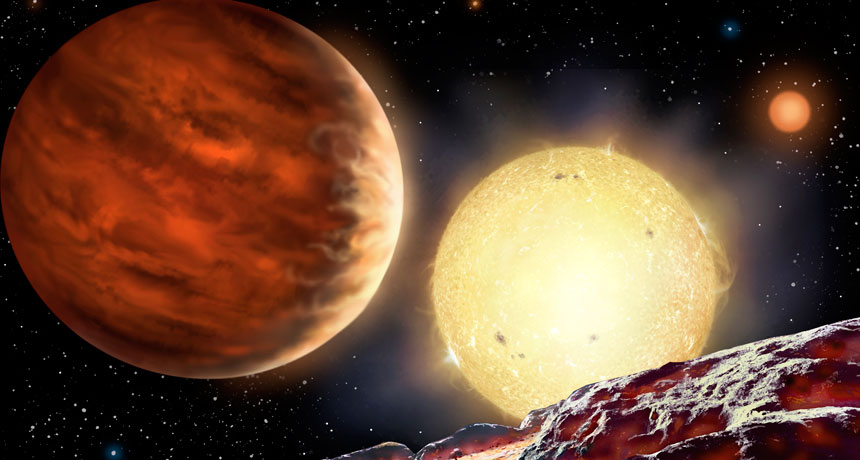Teen finds exoplanet
At 15, British student may be the youngest person ever to discover another world

An artist's impression of WASP-142b, at upper left, as seen from a hypothetical moon. The planet, found by student Tom Wagg when just 15, is 1,000 light years from Earth. Credit: David A. Hardy
A student in England may be the youngest person ever to find a planet.
Tom Wagg discovered the planet orbiting a star far beyond our solar system. He was just starting a weeklong internship at a local university. “I got trained on the first day and found it on the second,” he tells Science News for Students.
Wagg’s planet is for now named WASP-142b. It is an extrasolar planet, or exoplanet. These are planets that orbit stars other than our own sun. So far, more than 1,000 such worlds have been discovered. The planet is about 1,000 light years from Earth. It orbits a binary star located in the constellation Hydra.

Tom, now 17, found the planet two years ago while doing an internship at Keele University, near his hometown of Newcastle-under-Lyme in England. Keele University in England just announced the teen’s achievement on June 10.
This university is part of the Wide Angle Search for Planets, or WASP, collaboration. The project is one of the leaders in discovering extrasolar planets.
“Tom is keen to learn about science, so it was easy to train him to look for planets,” says Coel Hellier. Hellier is an astrophysicist. He leads the WASP project at Keele.
WASP works by monitoring millions of stars. When an extrasolar planet passes in front of its star, the star’s brightness dips slightly. (That passage is called a transit.) Tom was poring over data collected by the project when he spotted such a dip. This initial discovery took professional astronomers two more years to confirm.
WASP-142b is about the same size as Jupiter. Since the planet is so large and its host star is very bright, WASP-142b likely will be subjected to many more follow-up observations, says Kipping.
“I expect astronomers will be looking at Tom’s planet in the future and trying to measure its atmosphere,” Kipping adds. The planet completes a full orbit of its star every two days. That frequency will give astronomers lots of opportunities to observe WASP-142b as it crosses the face of its star. Observations of the light shining through the planet’s atmosphere could help to reveal its composition.Tom’s discovery is “a testament to the accessibility and appeal of looking for planets,” Kipping says.
Tom still has another year of school before he heads off to university. He hopes to study physics at Oxford University or another school in England.
Power Words
(for more about Power Words, click here)
atmosphere The envelope of gases surrounding Earth or another planet.
astronomy The area of science that deals with celestial objects, space and the physical universe as a whole. People who work in this field are called astronomers.
astrophysics An area of astronomy that deals with understanding the physical nature of stars and other objects in space. People who work in this field are known as astrophysicists.
binary star A system of two stars in which one revolves around the other, or they both revolve around a common center.
constellation Patterns formed by prominent stars that lie close to each other in the night sky. Modern astronomers divide the sky into 88 constellations, 12 of which (known as the zodiac) lie along the sun’s path through the sky over the course of a year. Cancri, the original Greek name for the constellation Cancer, is one of those 12 zodiac constellations.
exoplanet A planet that orbits a star outside the solar system. Also called an extrasolar planet.
internship A training program where students learn advanced professional skills by working alongside experts. People who participate in these training programs are called interns. Some intern in medicine, others in the sciences, journalism or business.
Jupiter (in astronomy) The solar system’s largest planet, it has the shortest day length (10 hours). A gas giant, its low density indicates that this planet is composed of light elements, such as hydrogen and helium. This planet also releases more heat than it receives from the sun as gravity compresses its mass (and slowly shrinks the planet).
light-year The distance light travels in one year, about 9.48 trillion kilometers (almost 6 trillion miles). To get some idea of this length, imagine a rope long enough to wrap around the Earth. It would be a little over 40,000 kilometers (24,900 miles) long. Lay it out straight. Now lay another 236 million more that are the same length, end-to-end, right after the first. The total distance they now span would equal one light-year.
orbit The curved path of a celestial object or spacecraft around a star, planet or moon. One complete circuit around a celestial body.
physics The scientific study of the nature and properties of matter and energy. Classical physics is an explanation of the nature and properties of matter and energy that relies on descriptions such as Newton’s laws of motion. It’s an alternative to quantum physics in explaining the motions and behavior of matter. A scientist who works in that field is known as a physicist.
planet A celestial object that orbits a star, is big enough for gravity to have squashed it into a roundish ball and it must have cleared other objects out of the way in its orbital neighborhood. To accomplish the third feat, it must be big enough to pull neighboring objects into the planet itself or to sling-shot them around the planet and off into outer space. Astronomers of the International Astronomical Union (IAU) created this three-part scientific definition of a planet in August 2006 to determine Pluto’s status. Based on that definition, IAU ruled that Pluto did not qualify. The solar system now consists of eight planets: Mercury, Venus, Earth, Mars, Jupiter, Saturn, Uranus and Neptune.
solar Having to do with the sun, including the light and energy it gives off.
solar system The eight major planets and their moons in orbit around the sun, together with smaller bodies in the form of dwarf planets, asteroids, meteoroids and comets.
star Thebasic building block from which galaxies are made. Stars develop when gravity compacts clouds of gas. When they become dense enough to sustain nuclear-fusion reactions, stars will emit light and sometimes other forms of electromagnetic radiation. The sun is our closest star.
transit (in astronomy) The passing of a planet across the face of a star, or of a moon or its shadow across the face of a planet.







